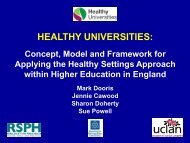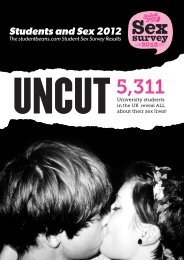Mental health of students in higher education
Mental health of students in higher education - Royal College of ...
Mental health of students in higher education - Royal College of ...
- No tags were found...
You also want an ePaper? Increase the reach of your titles
YUMPU automatically turns print PDFs into web optimized ePapers that Google loves.
College Report CR166the first, the victim is physically forced <strong>in</strong>to a sexual act. In the second, sheis <strong>in</strong>capacitated by be<strong>in</strong>g <strong>in</strong>toxicated with drugs or alcohol. The substancemay be taken voluntarily or adm<strong>in</strong>istered surreptitiously by the perpetrator.It is well known that sexual assault <strong>in</strong> childhood or adolescence is associatedwith a <strong>higher</strong> risk <strong>of</strong> sexual assault <strong>in</strong> adult life (van der Kolk, 1989). Thisstudy was based on an onl<strong>in</strong>e survey <strong>of</strong> over 5000 women undergraduates.The researchers found that experience <strong>of</strong> physically forced sexual assaultbefore start<strong>in</strong>g college was associated with a substantially <strong>in</strong>creasedrisk (nearly sevenfold) <strong>of</strong> forcible assault while at college. Incapacitatedassault before start<strong>in</strong>g college was similarly associated with a <strong>higher</strong> risk<strong>of</strong> <strong>in</strong>capacitated assault as a student. Use <strong>of</strong> marijuana and gett<strong>in</strong>g drunk<strong>in</strong>creased the risk <strong>of</strong> <strong>in</strong>capacitated assault but not forcible assault. It wasfurther revealed that 16.5% <strong>of</strong> women <strong>students</strong> had been threatened orhumiliated and 5.7% had been physically hurt by an <strong>in</strong>timate partner. Insome <strong>of</strong> these women, forced sexual assault was a repeated event.McCauley et al (2009) carried out a survey <strong>of</strong> 1980 women <strong>students</strong>aged 18–34 years. In 11.3% <strong>of</strong> the sample a lifetime history <strong>of</strong> rape wasreported. As <strong>in</strong> the Krebs et al study, <strong>in</strong>capacitated rape, but not forciblerape, was associated with drug use and b<strong>in</strong>ge dr<strong>in</strong>k<strong>in</strong>g. Messman-Mooreet al (2005) found that the presence <strong>of</strong> symptoms <strong>of</strong> post-traumaticstress disorder (PTSD) was associated with an <strong>in</strong>creased risk <strong>of</strong> rape. Theysuggested that one reason why women with a history <strong>of</strong> sexual abuse orassault may be at risk is because they use alcohol or drugs as a way <strong>of</strong>alleviat<strong>in</strong>g the distress caused by PTSD symptoms.Amar & Gennaro (2005) studied the prevalence <strong>of</strong> violence perpetratedby <strong>in</strong>timate partners <strong>in</strong> a cohort <strong>of</strong> college women aged 18–25 years <strong>in</strong> theUSA and the relationship between this and psychiatric morbidity. ‘Violence’embraced psychological abuse, <strong>in</strong>timidation, threats and coercion as wellas physical violence. Seventy per cent <strong>of</strong> the sample was Black, althoughthere was no difference <strong>in</strong> race between victims and non-victims <strong>of</strong> violence.Psychiatric morbidity was assessed by the SCL-90. Some form <strong>of</strong> violencehad been experienced by 48% <strong>of</strong> the cohort and <strong>of</strong> these, a third reportedphysical <strong>in</strong>jury. In 13% <strong>of</strong> those report<strong>in</strong>g physical <strong>in</strong>jury, this was describedas ‘severe’. Scores on the SCL-90 were <strong>higher</strong> <strong>in</strong> victims <strong>of</strong> violencecompared with non-victims and <strong>higher</strong> still <strong>in</strong> those who had been subject tomultiple forms <strong>of</strong> violence.Stepak<strong>of</strong>f (1998) surveyed a cohort <strong>of</strong> female undergraduate <strong>students</strong>.Participants completed self-report measures <strong>of</strong> sexual victimisation,hopelessness, suicidal ideation and suicidal behaviour. Adult sexualvictimisation predicted current hopelessness and suicidal ideation. Bothchildhood sexual abuse and adult sexual victimisation predicted suicidalbehaviour. One <strong>in</strong> four victims <strong>of</strong> rape, <strong>in</strong> contrast to approximately one <strong>in</strong>20 women who had not been victims, had engaged <strong>in</strong> a suicidal act.Changes over timeAs mentioned earlier, there is a widespread perception that levels <strong>of</strong>disturbance exhibited by clients at student counsell<strong>in</strong>g services have<strong>in</strong>creased <strong>in</strong> recent decades. This has been noted both <strong>in</strong> the UK and theUSA. This observation raises a number <strong>of</strong> important questions. The first iswhether the prevalence <strong>of</strong> psychiatric disorders is <strong>in</strong>creas<strong>in</strong>g or whetherthere is a change <strong>in</strong> the numbers <strong>of</strong> <strong>students</strong> seek<strong>in</strong>g help from counsell<strong>in</strong>gand other services. If the latter, the question then arises as to whether this30 http://www.rcpsych.ac.uk





